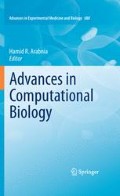Abstract
This paper presents an artificial immune system (AIS) based on Grossman’s tunable activation threshold (TAT) for temporal anomaly detection. We describe the generic AIS framework and the TAT model adopted for simulating T Cells behaviour, emphasizing two novel important features: the temporal dynamic adjustment of T Cells clonal size and its associated homeostasis mechanism. We also present some promising results obtained with artificially generated data sets, aiming to test the appropriateness of using TAT in dynamic changing environments, to distinguish new unseen patterns as part of what should be detected as normal or as anomalous. We conclude by discussing results obtained thus far with artificially generated data sets.
Access this chapter
Tax calculation will be finalised at checkout
Purchases are for personal use only
References
Antunes M, Correia E (2008) TAT-NIDS: an immune-based anomaly detection architecture for network intrusion detection, Proceedings of IWPACBB’08 – Advances in Soft Computing (Springer), pp 60–67
Antunes M, Correia E, Carneiro J (2009) Towards an immune-inspired temporal anomaly detection algorithm based on tunable activation thresholds, Proceedings of International Conference of Bioinspired systems and signal processing (BIOSIGNALS), pp 357–362
Antunes M, Correia E (2009) An Artificial Immune System for Temporal Anomaly Detection Using Cell Activation Thresholds and Clonal Size Regulation with Homeostasis, Proceedings of International Joint Conferences on Bioinformatics, Systems Biology and Intelligent Computing (IJCBS), pp 323–326
Burmester G, Pezzuto A (2003) Color Atlas of Immunology. Thieme Medical Publishers, George Thieme Verlag
Burnet F (1959) The Clonal Selection Theory of Acquired Immunity, Vanderbilt University Press Nashville, Tennesse
Carneiro J, Paixão T et al (2005) Immunological self-tolerance: Lessons from mathematical modeling, Journal of Computational and Applied Mathematics 184(1):77–100
Castro L, Timmis J (2002) Artificial Immune Systems: A New Computational Intelligence Approach. Springer, New York
Grossman Z and Singer A (1996), Tuning of activation thresholds explains flexibility in the selection and development of Tcells in the thymus, Proceedings of the National Academy of Sciences 93(25):14747–14752
Kim J, Bentley P (2001) An evaluation of negative selection in an artificial immune system for network intrusion detection, Proceedings of Genetic and Evolutionary Computation Conference (GECCO), 1330–1337
Kim J, Bentley P, Aickelin U, Greensmith J, Tedesco G, and Twycross J (2007) Immune system approaches to intrusion detection – a review, Natural Computing 6(4):413–466
Matzinger P (2002) The danger model: a renewed sense of self, Science’s STKE 296(5566):301–305
Pedroso J (2007) Simple Metaheuristics Using the Simplex Algorithm for Non-linear Programming, Engineering Stochastic Local Search Algorithms. Designing, Implementing and Analyzing Effective Heuristics – LNCS (Springer), 4638:217–221
Stibor T, Timmis J and Eckert C (2005) On the appropriateness of negative selection defined over hamming shape-space as a network intrusion detection system, Proceedings of IEEE congress on Evolutionary Computation (CEC) 2:995–1002
Vance R (2000) Cutting edge commentary: A Copernican revolution? doubts about the danger theory, The Journal of Immunology 165:1725–1728
van den Berg H and Rand D (2004) Dynamics of T cell activation threshold tuning, Journal of Theoretical Biology 228(3):397–416
Acknowledgements
The authors acknowledge the facilities provided by the CRACS research unit, an INESC associate of the Faculty of Science, University of Porto.
Author information
Authors and Affiliations
Corresponding author
Editor information
Editors and Affiliations
Rights and permissions
Copyright information
© 2010 Springer Science+Business Media, LLC
About this paper
Cite this paper
Antunes, M.J., Correia, M.E. (2010). Temporal Anomaly Detection: An Artificial Immune Approach Based on T Cell Activation, Clonal Size Regulation and Homeostasis. In: Arabnia, H. (eds) Advances in Computational Biology. Advances in Experimental Medicine and Biology, vol 680. Springer, New York, NY. https://doi.org/10.1007/978-1-4419-5913-3_33
Download citation
DOI: https://doi.org/10.1007/978-1-4419-5913-3_33
Published:
Publisher Name: Springer, New York, NY
Print ISBN: 978-1-4419-5912-6
Online ISBN: 978-1-4419-5913-3
eBook Packages: Biomedical and Life SciencesBiomedical and Life Sciences (R0)

